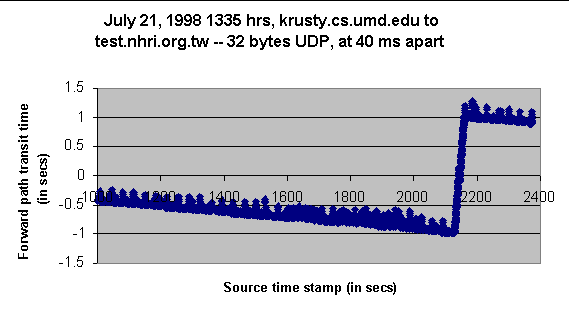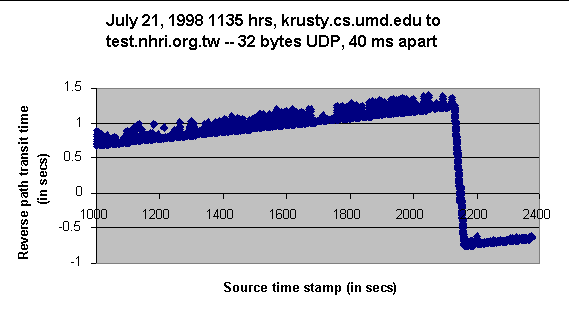Here we present an example of an end host clock adjustment phenomenon that was captured using the NetDyn tool.
This example is from an experiment in which UDP packets, each containing 32 bytes of data, were sent from krusty.cs.umd.edu to test.nhri.org.tw (Taiwan), with the inter-packet gap being 40 ms. This experiment was conducted on July 23, 1998 at 1335 hrs EST.
Below we show the graphs plotting the forward and reverse path transit times for the experiment against the packet source time stamp values. Note, since the forward path transit time is the difference between the time stamp at the source and the echo hosts. Since, the clocks at these two machines are not synchronized, the transit time can be positive or negative depending on how far the two clocks are skewed. The same holds for the reverse path transit time. The actual transit time is of little importance to us in this example.


There are two interesting observations to be made from these graphs. First, there exists a sudden shift in the transit times at around time 2150, and this shift is about +2 seconds for the forward path and about -2 seconds for the reverse path. Both the shifts take place around the same time. Also, the direction of the shift in the forward path is the opposite of that of the reverse path. A suitable explanation for this would be that the echo host adjusted its clock forward by about 2 seconds (or the source host adjusted its clock backward by 2 seconds).
The other observation is that the most observed transit time in both paths do not remain at a constant value, but they vary linearly with slopes of equal magnitude, but of opposite signs. This can be explained by the fact that the clocks of the two end hosts are not skewed by a constant time difference. There is a continuous clock drift (which leads to periodic clock adjustment from that end host). By observing the slope of the most observed transit time, we can conclude that the clocks of the two end hosts drift apart at the rate of 0.5 seconds every 2000 seconds.
[Top] [Studies in 1997-98] [Back to NetCalliper Project]
![]()